HI6008 Literature Review: International Students & Australian Economy
VerifiedAdded on 2023/06/12
|14
|4088
|197
Literature Review
AI Summary
This literature review explores the impact of international students on the Australian economy, analyzing both advantages and disadvantages. The study highlights the significant contribution of international education to Australia's export revenue and GDP, emphasizing the financial benefits to educational institutions and related industries such as food, accommodation, and transport. It also discusses the fostering of long-term goodwill and international understanding, the reinvestment of economic advantages in education and research, and the potential for skilled immigration. Simultaneously, the review acknowledges potential risks and challenges associated with the growth of international education, including the need for collaboration between government departments to maintain the quality and reputation of the Australian education system. The review draws upon various sources, including Deloitte Access Economics reports and Department of Education and Training data, to provide a comprehensive overview of the complex relationship between international students and the Australian economy.
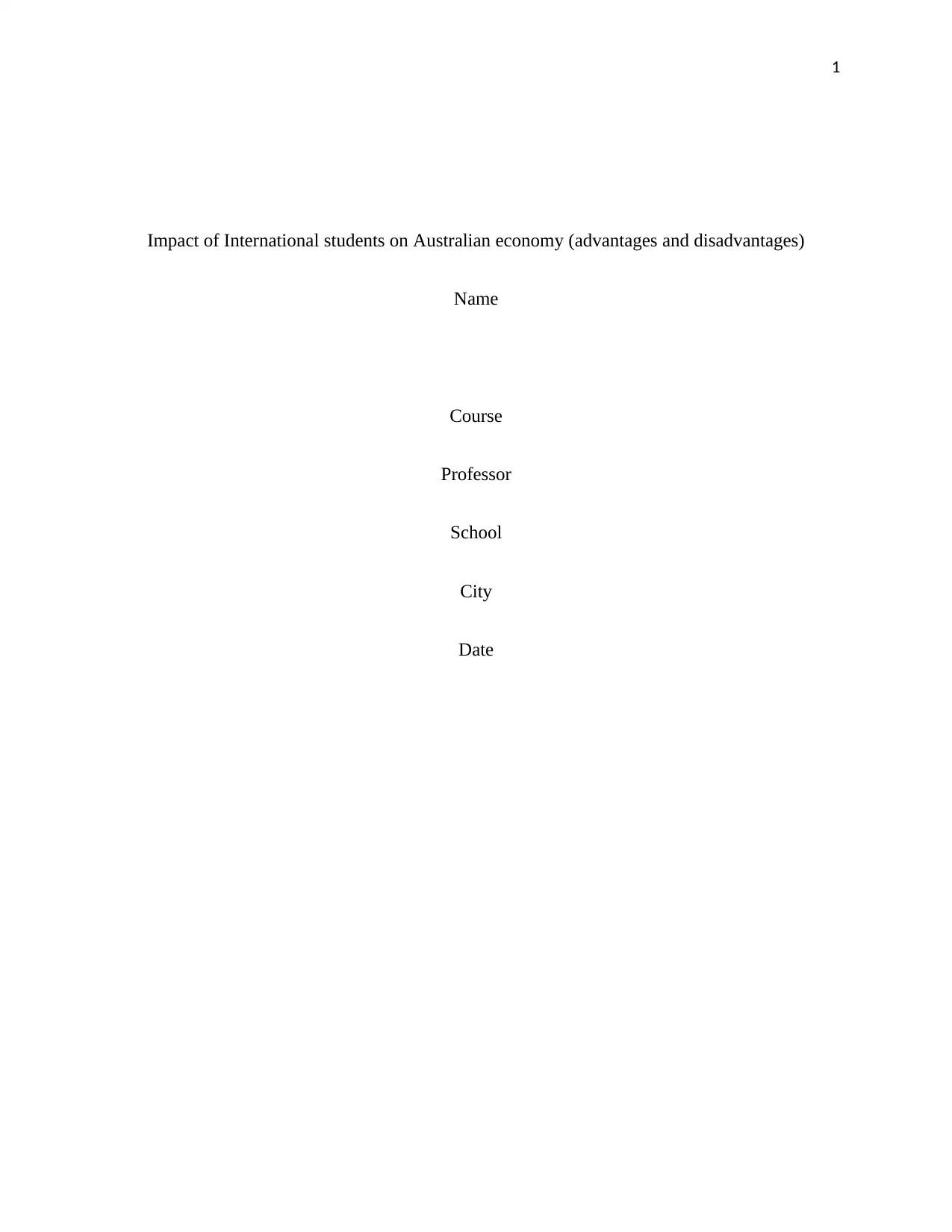
1
Impact of International students on Australian economy (advantages and disadvantages)
Name
Course
Professor
School
City
Date
Impact of International students on Australian economy (advantages and disadvantages)
Name
Course
Professor
School
City
Date
Paraphrase This Document
Need a fresh take? Get an instant paraphrase of this document with our AI Paraphraser
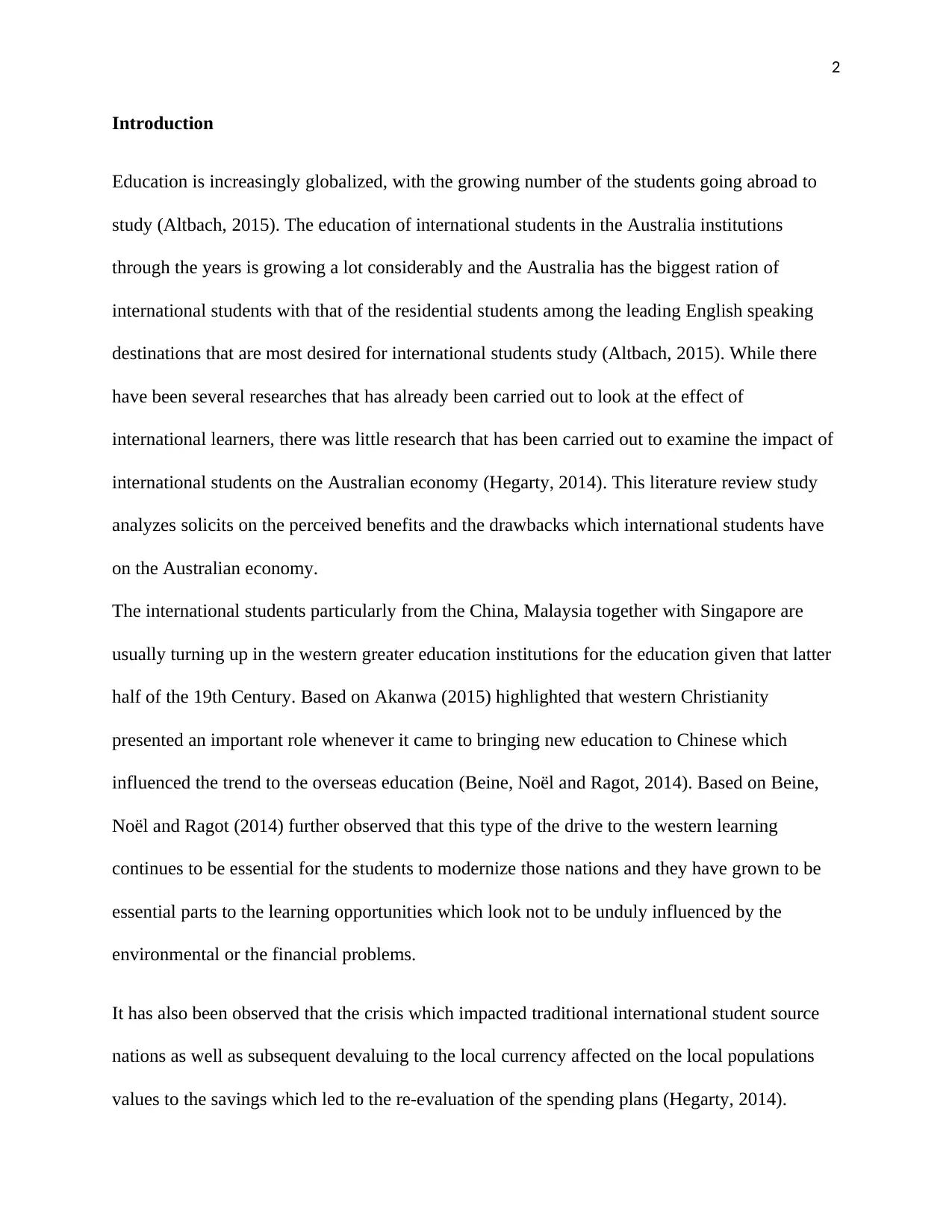
2
Introduction
Education is increasingly globalized, with the growing number of the students going abroad to
study (Altbach, 2015). The education of international students in the Australia institutions
through the years is growing a lot considerably and the Australia has the biggest ration of
international students with that of the residential students among the leading English speaking
destinations that are most desired for international students study (Altbach, 2015). While there
have been several researches that has already been carried out to look at the effect of
international learners, there was little research that has been carried out to examine the impact of
international students on the Australian economy (Hegarty, 2014). This literature review study
analyzes solicits on the perceived benefits and the drawbacks which international students have
on the Australian economy.
The international students particularly from the China, Malaysia together with Singapore are
usually turning up in the western greater education institutions for the education given that latter
half of the 19th Century. Based on Akanwa (2015) highlighted that western Christianity
presented an important role whenever it came to bringing new education to Chinese which
influenced the trend to the overseas education (Beine, Noël and Ragot, 2014). Based on Beine,
Noël and Ragot (2014) further observed that this type of the drive to the western learning
continues to be essential for the students to modernize those nations and they have grown to be
essential parts to the learning opportunities which look not to be unduly influenced by the
environmental or the financial problems.
It has also been observed that the crisis which impacted traditional international student source
nations as well as subsequent devaluing to the local currency affected on the local populations
values to the savings which led to the re-evaluation of the spending plans (Hegarty, 2014).
Introduction
Education is increasingly globalized, with the growing number of the students going abroad to
study (Altbach, 2015). The education of international students in the Australia institutions
through the years is growing a lot considerably and the Australia has the biggest ration of
international students with that of the residential students among the leading English speaking
destinations that are most desired for international students study (Altbach, 2015). While there
have been several researches that has already been carried out to look at the effect of
international learners, there was little research that has been carried out to examine the impact of
international students on the Australian economy (Hegarty, 2014). This literature review study
analyzes solicits on the perceived benefits and the drawbacks which international students have
on the Australian economy.
The international students particularly from the China, Malaysia together with Singapore are
usually turning up in the western greater education institutions for the education given that latter
half of the 19th Century. Based on Akanwa (2015) highlighted that western Christianity
presented an important role whenever it came to bringing new education to Chinese which
influenced the trend to the overseas education (Beine, Noël and Ragot, 2014). Based on Beine,
Noël and Ragot (2014) further observed that this type of the drive to the western learning
continues to be essential for the students to modernize those nations and they have grown to be
essential parts to the learning opportunities which look not to be unduly influenced by the
environmental or the financial problems.
It has also been observed that the crisis which impacted traditional international student source
nations as well as subsequent devaluing to the local currency affected on the local populations
values to the savings which led to the re-evaluation of the spending plans (Hegarty, 2014).
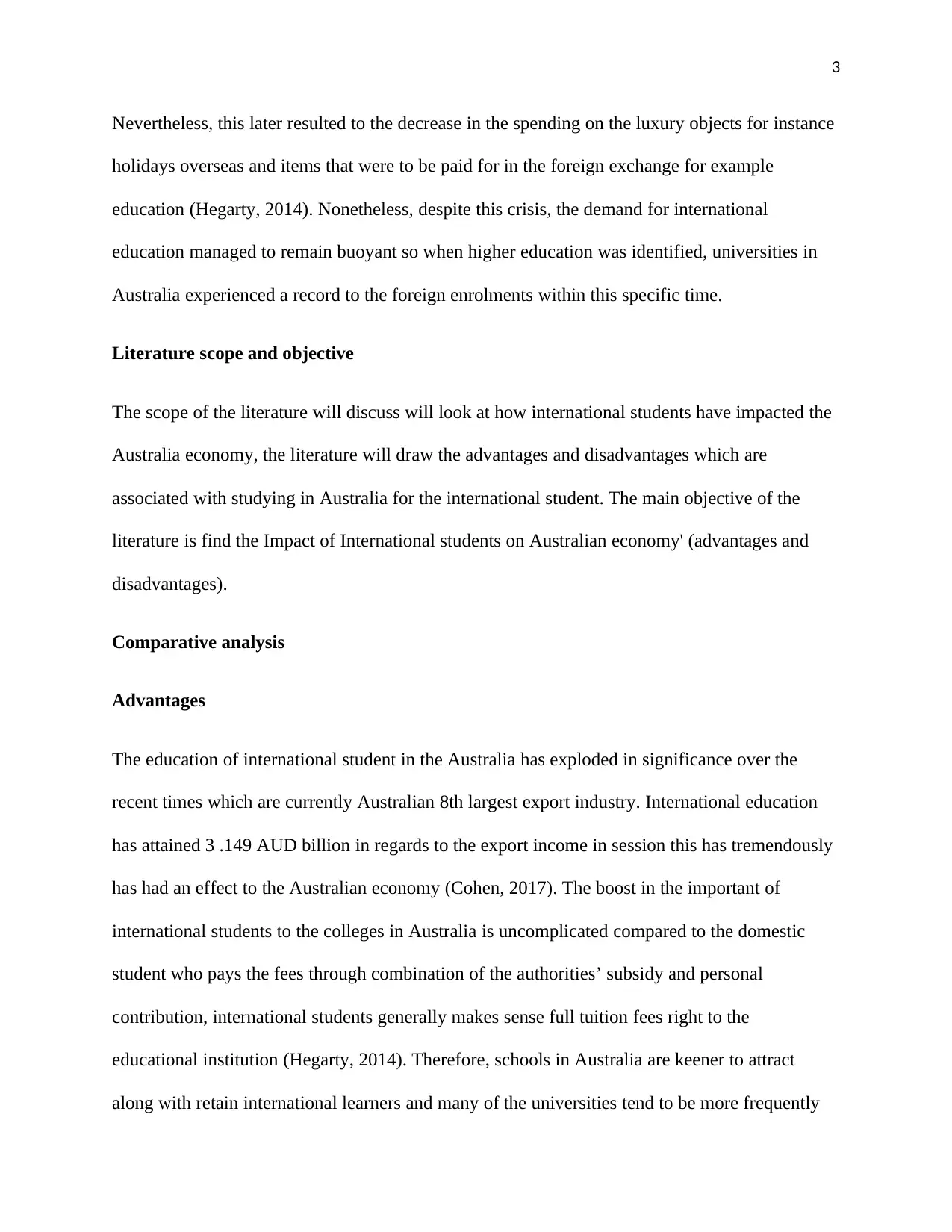
3
Nevertheless, this later resulted to the decrease in the spending on the luxury objects for instance
holidays overseas and items that were to be paid for in the foreign exchange for example
education (Hegarty, 2014). Nonetheless, despite this crisis, the demand for international
education managed to remain buoyant so when higher education was identified, universities in
Australia experienced a record to the foreign enrolments within this specific time.
Literature scope and objective
The scope of the literature will discuss will look at how international students have impacted the
Australia economy, the literature will draw the advantages and disadvantages which are
associated with studying in Australia for the international student. The main objective of the
literature is find the Impact of International students on Australian economy' (advantages and
disadvantages).
Comparative analysis
Advantages
The education of international student in the Australia has exploded in significance over the
recent times which are currently Australian 8th largest export industry. International education
has attained 3 .149 AUD billion in regards to the export income in session this has tremendously
has had an effect to the Australian economy (Cohen, 2017). The boost in the important of
international students to the colleges in Australia is uncomplicated compared to the domestic
student who pays the fees through combination of the authorities’ subsidy and personal
contribution, international students generally makes sense full tuition fees right to the
educational institution (Hegarty, 2014). Therefore, schools in Australia are keener to attract
along with retain international learners and many of the universities tend to be more frequently
Nevertheless, this later resulted to the decrease in the spending on the luxury objects for instance
holidays overseas and items that were to be paid for in the foreign exchange for example
education (Hegarty, 2014). Nonetheless, despite this crisis, the demand for international
education managed to remain buoyant so when higher education was identified, universities in
Australia experienced a record to the foreign enrolments within this specific time.
Literature scope and objective
The scope of the literature will discuss will look at how international students have impacted the
Australia economy, the literature will draw the advantages and disadvantages which are
associated with studying in Australia for the international student. The main objective of the
literature is find the Impact of International students on Australian economy' (advantages and
disadvantages).
Comparative analysis
Advantages
The education of international student in the Australia has exploded in significance over the
recent times which are currently Australian 8th largest export industry. International education
has attained 3 .149 AUD billion in regards to the export income in session this has tremendously
has had an effect to the Australian economy (Cohen, 2017). The boost in the important of
international students to the colleges in Australia is uncomplicated compared to the domestic
student who pays the fees through combination of the authorities’ subsidy and personal
contribution, international students generally makes sense full tuition fees right to the
educational institution (Hegarty, 2014). Therefore, schools in Australia are keener to attract
along with retain international learners and many of the universities tend to be more frequently
⊘ This is a preview!⊘
Do you want full access?
Subscribe today to unlock all pages.

Trusted by 1+ million students worldwide
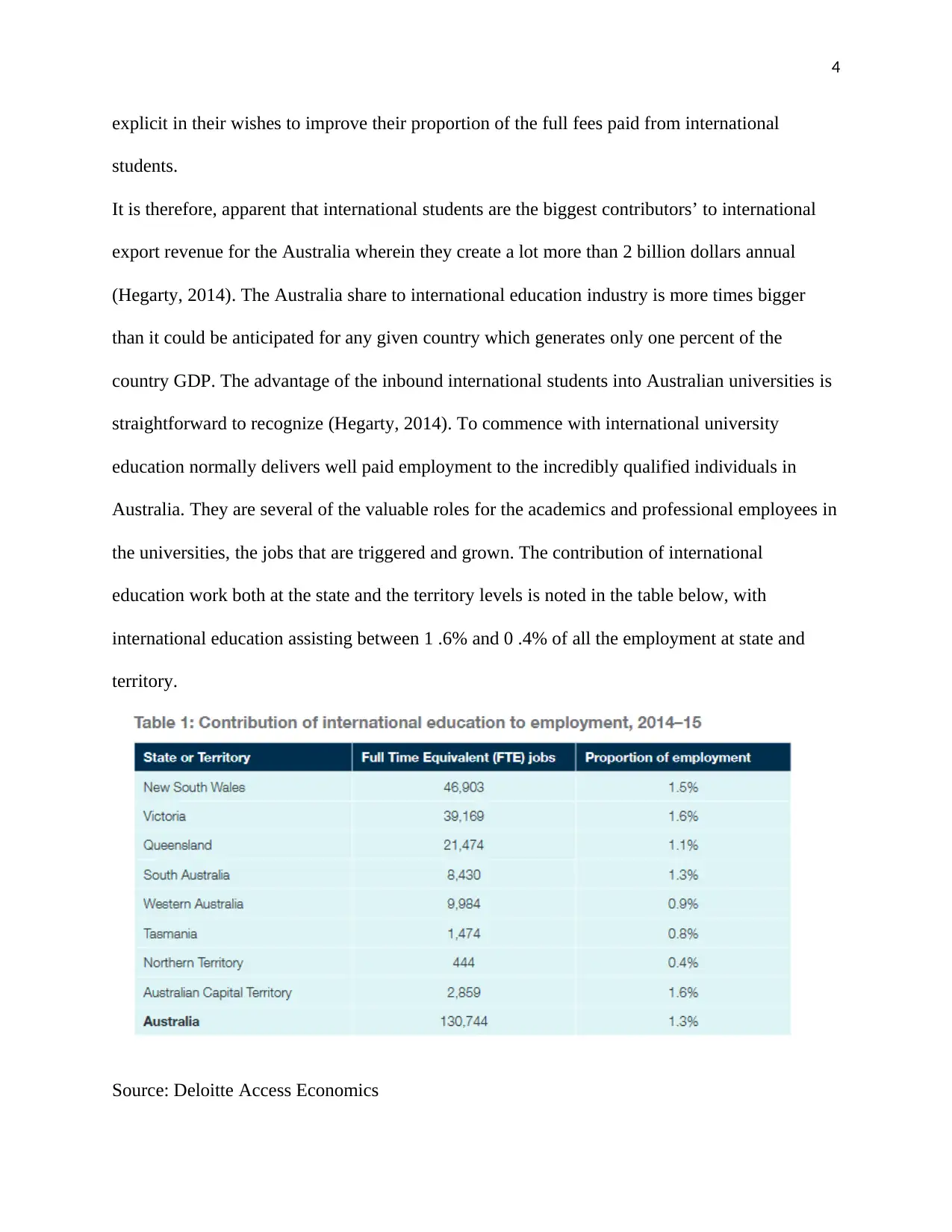
4
explicit in their wishes to improve their proportion of the full fees paid from international
students.
It is therefore, apparent that international students are the biggest contributors’ to international
export revenue for the Australia wherein they create a lot more than 2 billion dollars annual
(Hegarty, 2014). The Australia share to international education industry is more times bigger
than it could be anticipated for any given country which generates only one percent of the
country GDP. The advantage of the inbound international students into Australian universities is
straightforward to recognize (Hegarty, 2014). To commence with international university
education normally delivers well paid employment to the incredibly qualified individuals in
Australia. They are several of the valuable roles for the academics and professional employees in
the universities, the jobs that are triggered and grown. The contribution of international
education work both at the state and the territory levels is noted in the table below, with
international education assisting between 1 .6% and 0 .4% of all the employment at state and
territory.
Source: Deloitte Access Economics
explicit in their wishes to improve their proportion of the full fees paid from international
students.
It is therefore, apparent that international students are the biggest contributors’ to international
export revenue for the Australia wherein they create a lot more than 2 billion dollars annual
(Hegarty, 2014). The Australia share to international education industry is more times bigger
than it could be anticipated for any given country which generates only one percent of the
country GDP. The advantage of the inbound international students into Australian universities is
straightforward to recognize (Hegarty, 2014). To commence with international university
education normally delivers well paid employment to the incredibly qualified individuals in
Australia. They are several of the valuable roles for the academics and professional employees in
the universities, the jobs that are triggered and grown. The contribution of international
education work both at the state and the territory levels is noted in the table below, with
international education assisting between 1 .6% and 0 .4% of all the employment at state and
territory.
Source: Deloitte Access Economics
Paraphrase This Document
Need a fresh take? Get an instant paraphrase of this document with our AI Paraphraser
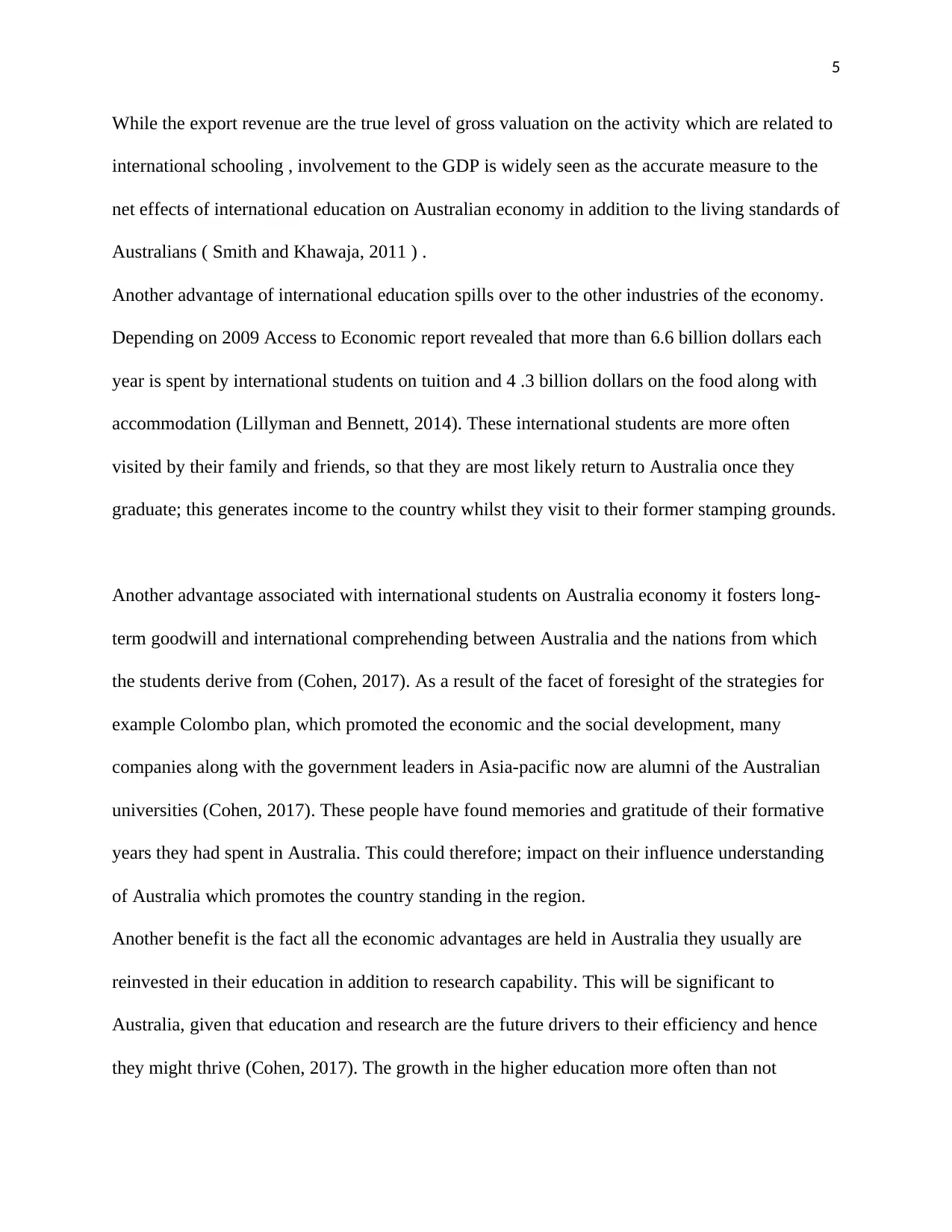
5
While the export revenue are the true level of gross valuation on the activity which are related to
international schooling , involvement to the GDP is widely seen as the accurate measure to the
net effects of international education on Australian economy in addition to the living standards of
Australians ( Smith and Khawaja, 2011 ) .
Another advantage of international education spills over to the other industries of the economy.
Depending on 2009 Access to Economic report revealed that more than 6.6 billion dollars each
year is spent by international students on tuition and 4 .3 billion dollars on the food along with
accommodation (Lillyman and Bennett, 2014). These international students are more often
visited by their family and friends, so that they are most likely return to Australia once they
graduate; this generates income to the country whilst they visit to their former stamping grounds.
Another advantage associated with international students on Australia economy it fosters long-
term goodwill and international comprehending between Australia and the nations from which
the students derive from (Cohen, 2017). As a result of the facet of foresight of the strategies for
example Colombo plan, which promoted the economic and the social development, many
companies along with the government leaders in Asia-pacific now are alumni of the Australian
universities (Cohen, 2017). These people have found memories and gratitude of their formative
years they had spent in Australia. This could therefore; impact on their influence understanding
of Australia which promotes the country standing in the region.
Another benefit is the fact all the economic advantages are held in Australia they usually are
reinvested in their education in addition to research capability. This will be significant to
Australia, given that education and research are the future drivers to their efficiency and hence
they might thrive (Cohen, 2017). The growth in the higher education more often than not
While the export revenue are the true level of gross valuation on the activity which are related to
international schooling , involvement to the GDP is widely seen as the accurate measure to the
net effects of international education on Australian economy in addition to the living standards of
Australians ( Smith and Khawaja, 2011 ) .
Another advantage of international education spills over to the other industries of the economy.
Depending on 2009 Access to Economic report revealed that more than 6.6 billion dollars each
year is spent by international students on tuition and 4 .3 billion dollars on the food along with
accommodation (Lillyman and Bennett, 2014). These international students are more often
visited by their family and friends, so that they are most likely return to Australia once they
graduate; this generates income to the country whilst they visit to their former stamping grounds.
Another advantage associated with international students on Australia economy it fosters long-
term goodwill and international comprehending between Australia and the nations from which
the students derive from (Cohen, 2017). As a result of the facet of foresight of the strategies for
example Colombo plan, which promoted the economic and the social development, many
companies along with the government leaders in Asia-pacific now are alumni of the Australian
universities (Cohen, 2017). These people have found memories and gratitude of their formative
years they had spent in Australia. This could therefore; impact on their influence understanding
of Australia which promotes the country standing in the region.
Another benefit is the fact all the economic advantages are held in Australia they usually are
reinvested in their education in addition to research capability. This will be significant to
Australia, given that education and research are the future drivers to their efficiency and hence
they might thrive (Cohen, 2017). The growth in the higher education more often than not
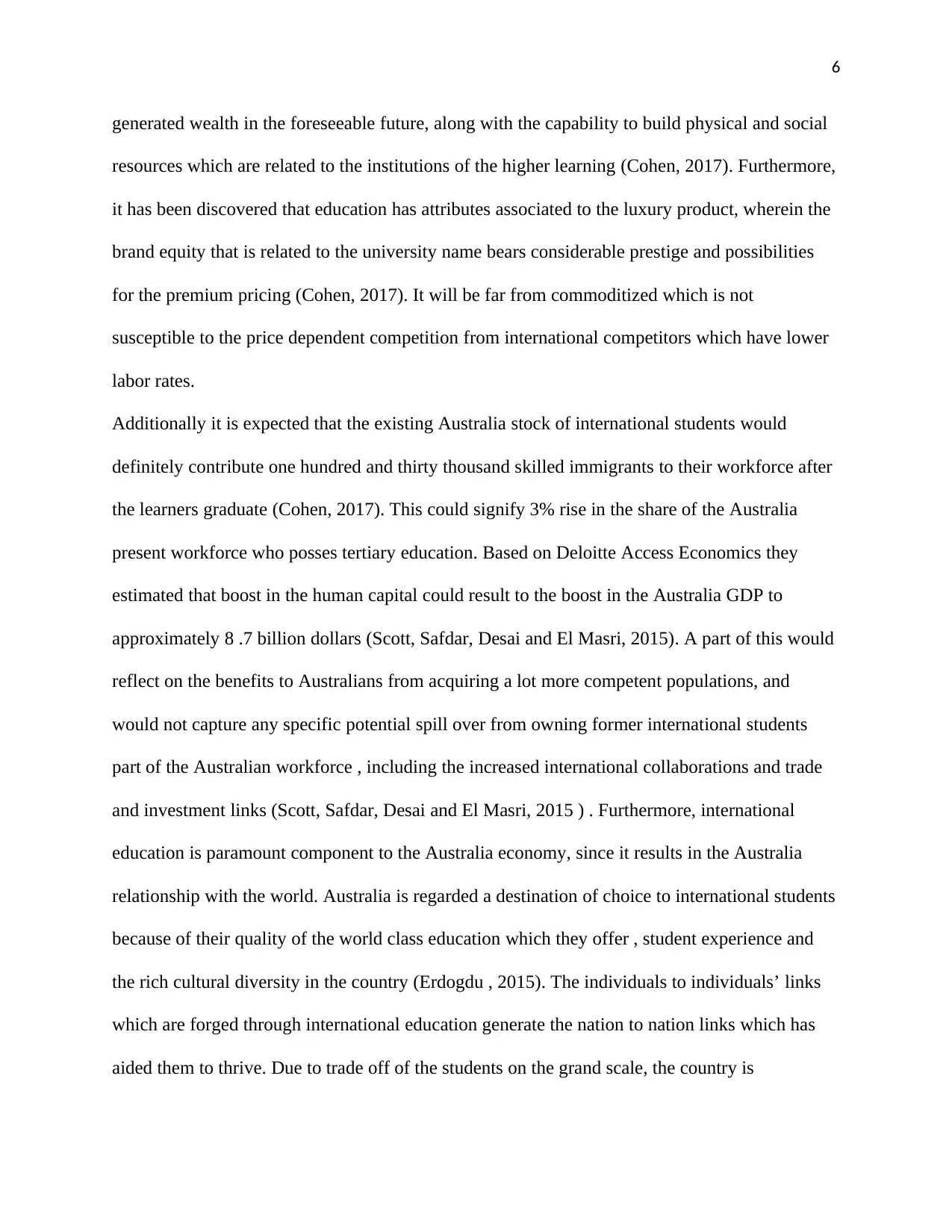
6
generated wealth in the foreseeable future, along with the capability to build physical and social
resources which are related to the institutions of the higher learning (Cohen, 2017). Furthermore,
it has been discovered that education has attributes associated to the luxury product, wherein the
brand equity that is related to the university name bears considerable prestige and possibilities
for the premium pricing (Cohen, 2017). It will be far from commoditized which is not
susceptible to the price dependent competition from international competitors which have lower
labor rates.
Additionally it is expected that the existing Australia stock of international students would
definitely contribute one hundred and thirty thousand skilled immigrants to their workforce after
the learners graduate (Cohen, 2017). This could signify 3% rise in the share of the Australia
present workforce who posses tertiary education. Based on Deloitte Access Economics they
estimated that boost in the human capital could result to the boost in the Australia GDP to
approximately 8 .7 billion dollars (Scott, Safdar, Desai and El Masri, 2015). A part of this would
reflect on the benefits to Australians from acquiring a lot more competent populations, and
would not capture any specific potential spill over from owning former international students
part of the Australian workforce , including the increased international collaborations and trade
and investment links (Scott, Safdar, Desai and El Masri, 2015 ) . Furthermore, international
education is paramount component to the Australia economy, since it results in the Australia
relationship with the world. Australia is regarded a destination of choice to international students
because of their quality of the world class education which they offer , student experience and
the rich cultural diversity in the country (Erdogdu , 2015). The individuals to individuals’ links
which are forged through international education generate the nation to nation links which has
aided them to thrive. Due to trade off of the students on the grand scale, the country is
generated wealth in the foreseeable future, along with the capability to build physical and social
resources which are related to the institutions of the higher learning (Cohen, 2017). Furthermore,
it has been discovered that education has attributes associated to the luxury product, wherein the
brand equity that is related to the university name bears considerable prestige and possibilities
for the premium pricing (Cohen, 2017). It will be far from commoditized which is not
susceptible to the price dependent competition from international competitors which have lower
labor rates.
Additionally it is expected that the existing Australia stock of international students would
definitely contribute one hundred and thirty thousand skilled immigrants to their workforce after
the learners graduate (Cohen, 2017). This could signify 3% rise in the share of the Australia
present workforce who posses tertiary education. Based on Deloitte Access Economics they
estimated that boost in the human capital could result to the boost in the Australia GDP to
approximately 8 .7 billion dollars (Scott, Safdar, Desai and El Masri, 2015). A part of this would
reflect on the benefits to Australians from acquiring a lot more competent populations, and
would not capture any specific potential spill over from owning former international students
part of the Australian workforce , including the increased international collaborations and trade
and investment links (Scott, Safdar, Desai and El Masri, 2015 ) . Furthermore, international
education is paramount component to the Australia economy, since it results in the Australia
relationship with the world. Australia is regarded a destination of choice to international students
because of their quality of the world class education which they offer , student experience and
the rich cultural diversity in the country (Erdogdu , 2015). The individuals to individuals’ links
which are forged through international education generate the nation to nation links which has
aided them to thrive. Due to trade off of the students on the grand scale, the country is
⊘ This is a preview!⊘
Do you want full access?
Subscribe today to unlock all pages.

Trusted by 1+ million students worldwide
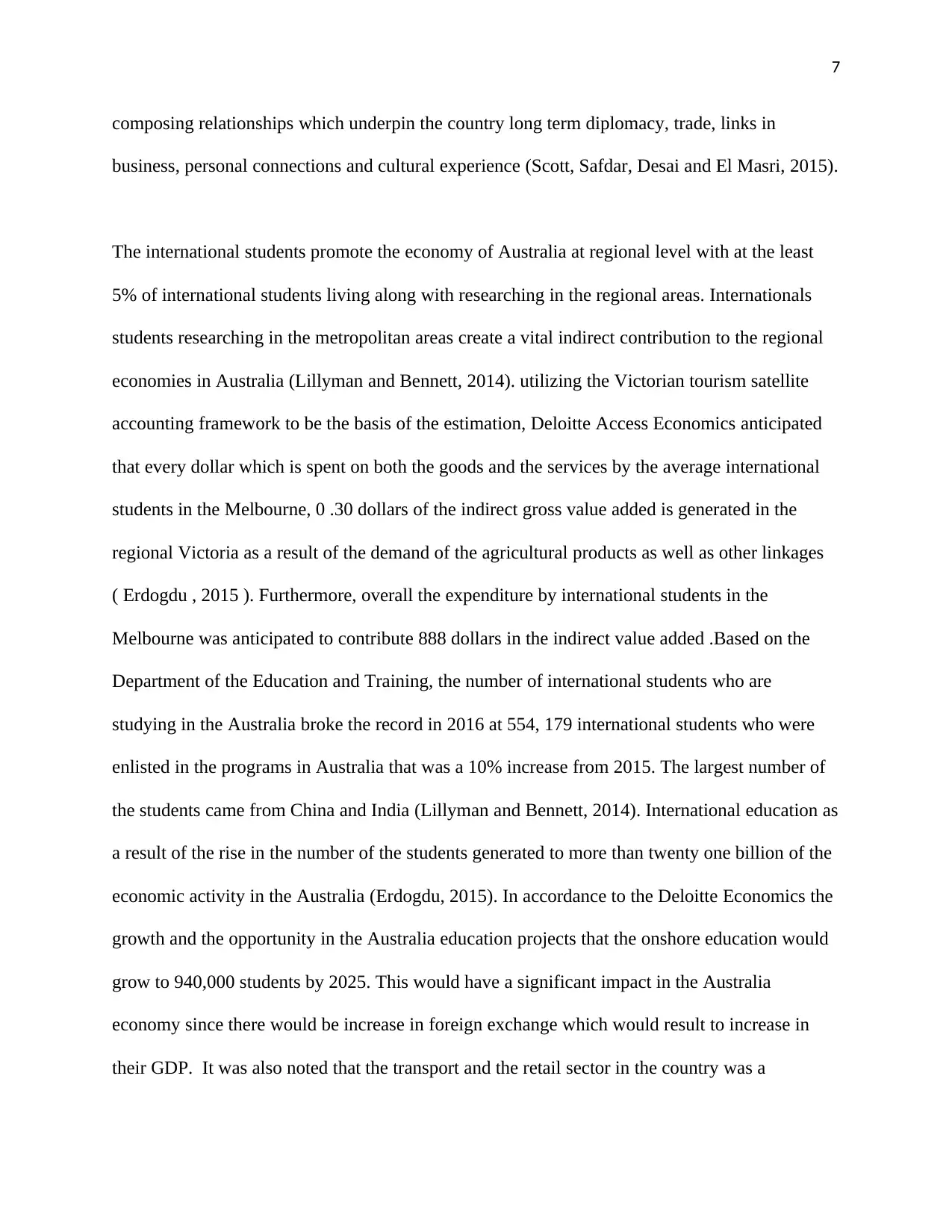
7
composing relationships which underpin the country long term diplomacy, trade, links in
business, personal connections and cultural experience (Scott, Safdar, Desai and El Masri, 2015).
The international students promote the economy of Australia at regional level with at the least
5% of international students living along with researching in the regional areas. Internationals
students researching in the metropolitan areas create a vital indirect contribution to the regional
economies in Australia (Lillyman and Bennett, 2014). utilizing the Victorian tourism satellite
accounting framework to be the basis of the estimation, Deloitte Access Economics anticipated
that every dollar which is spent on both the goods and the services by the average international
students in the Melbourne, 0 .30 dollars of the indirect gross value added is generated in the
regional Victoria as a result of the demand of the agricultural products as well as other linkages
( Erdogdu , 2015 ). Furthermore, overall the expenditure by international students in the
Melbourne was anticipated to contribute 888 dollars in the indirect value added .Based on the
Department of the Education and Training, the number of international students who are
studying in the Australia broke the record in 2016 at 554, 179 international students who were
enlisted in the programs in Australia that was a 10% increase from 2015. The largest number of
the students came from China and India (Lillyman and Bennett, 2014). International education as
a result of the rise in the number of the students generated to more than twenty one billion of the
economic activity in the Australia (Erdogdu, 2015). In accordance to the Deloitte Economics the
growth and the opportunity in the Australia education projects that the onshore education would
grow to 940,000 students by 2025. This would have a significant impact in the Australia
economy since there would be increase in foreign exchange which would result to increase in
their GDP. It was also noted that the transport and the retail sector in the country was a
composing relationships which underpin the country long term diplomacy, trade, links in
business, personal connections and cultural experience (Scott, Safdar, Desai and El Masri, 2015).
The international students promote the economy of Australia at regional level with at the least
5% of international students living along with researching in the regional areas. Internationals
students researching in the metropolitan areas create a vital indirect contribution to the regional
economies in Australia (Lillyman and Bennett, 2014). utilizing the Victorian tourism satellite
accounting framework to be the basis of the estimation, Deloitte Access Economics anticipated
that every dollar which is spent on both the goods and the services by the average international
students in the Melbourne, 0 .30 dollars of the indirect gross value added is generated in the
regional Victoria as a result of the demand of the agricultural products as well as other linkages
( Erdogdu , 2015 ). Furthermore, overall the expenditure by international students in the
Melbourne was anticipated to contribute 888 dollars in the indirect value added .Based on the
Department of the Education and Training, the number of international students who are
studying in the Australia broke the record in 2016 at 554, 179 international students who were
enlisted in the programs in Australia that was a 10% increase from 2015. The largest number of
the students came from China and India (Lillyman and Bennett, 2014). International education as
a result of the rise in the number of the students generated to more than twenty one billion of the
economic activity in the Australia (Erdogdu, 2015). In accordance to the Deloitte Economics the
growth and the opportunity in the Australia education projects that the onshore education would
grow to 940,000 students by 2025. This would have a significant impact in the Australia
economy since there would be increase in foreign exchange which would result to increase in
their GDP. It was also noted that the transport and the retail sector in the country was a
Paraphrase This Document
Need a fresh take? Get an instant paraphrase of this document with our AI Paraphraser
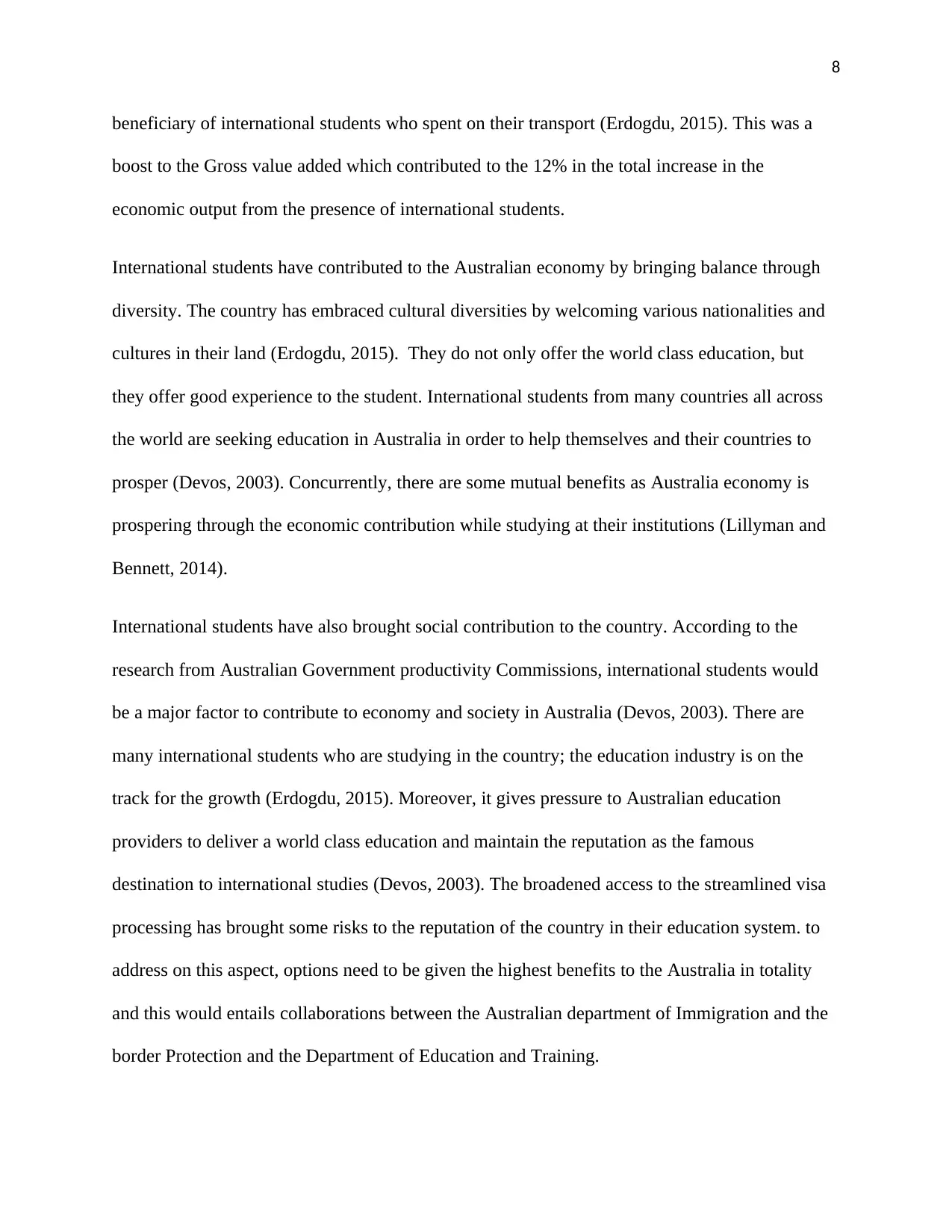
8
beneficiary of international students who spent on their transport (Erdogdu, 2015). This was a
boost to the Gross value added which contributed to the 12% in the total increase in the
economic output from the presence of international students.
International students have contributed to the Australian economy by bringing balance through
diversity. The country has embraced cultural diversities by welcoming various nationalities and
cultures in their land (Erdogdu, 2015). They do not only offer the world class education, but
they offer good experience to the student. International students from many countries all across
the world are seeking education in Australia in order to help themselves and their countries to
prosper (Devos, 2003). Concurrently, there are some mutual benefits as Australia economy is
prospering through the economic contribution while studying at their institutions (Lillyman and
Bennett, 2014).
International students have also brought social contribution to the country. According to the
research from Australian Government productivity Commissions, international students would
be a major factor to contribute to economy and society in Australia (Devos, 2003). There are
many international students who are studying in the country; the education industry is on the
track for the growth (Erdogdu, 2015). Moreover, it gives pressure to Australian education
providers to deliver a world class education and maintain the reputation as the famous
destination to international studies (Devos, 2003). The broadened access to the streamlined visa
processing has brought some risks to the reputation of the country in their education system. to
address on this aspect, options need to be given the highest benefits to the Australia in totality
and this would entails collaborations between the Australian department of Immigration and the
border Protection and the Department of Education and Training.
beneficiary of international students who spent on their transport (Erdogdu, 2015). This was a
boost to the Gross value added which contributed to the 12% in the total increase in the
economic output from the presence of international students.
International students have contributed to the Australian economy by bringing balance through
diversity. The country has embraced cultural diversities by welcoming various nationalities and
cultures in their land (Erdogdu, 2015). They do not only offer the world class education, but
they offer good experience to the student. International students from many countries all across
the world are seeking education in Australia in order to help themselves and their countries to
prosper (Devos, 2003). Concurrently, there are some mutual benefits as Australia economy is
prospering through the economic contribution while studying at their institutions (Lillyman and
Bennett, 2014).
International students have also brought social contribution to the country. According to the
research from Australian Government productivity Commissions, international students would
be a major factor to contribute to economy and society in Australia (Devos, 2003). There are
many international students who are studying in the country; the education industry is on the
track for the growth (Erdogdu, 2015). Moreover, it gives pressure to Australian education
providers to deliver a world class education and maintain the reputation as the famous
destination to international studies (Devos, 2003). The broadened access to the streamlined visa
processing has brought some risks to the reputation of the country in their education system. to
address on this aspect, options need to be given the highest benefits to the Australia in totality
and this would entails collaborations between the Australian department of Immigration and the
border Protection and the Department of Education and Training.
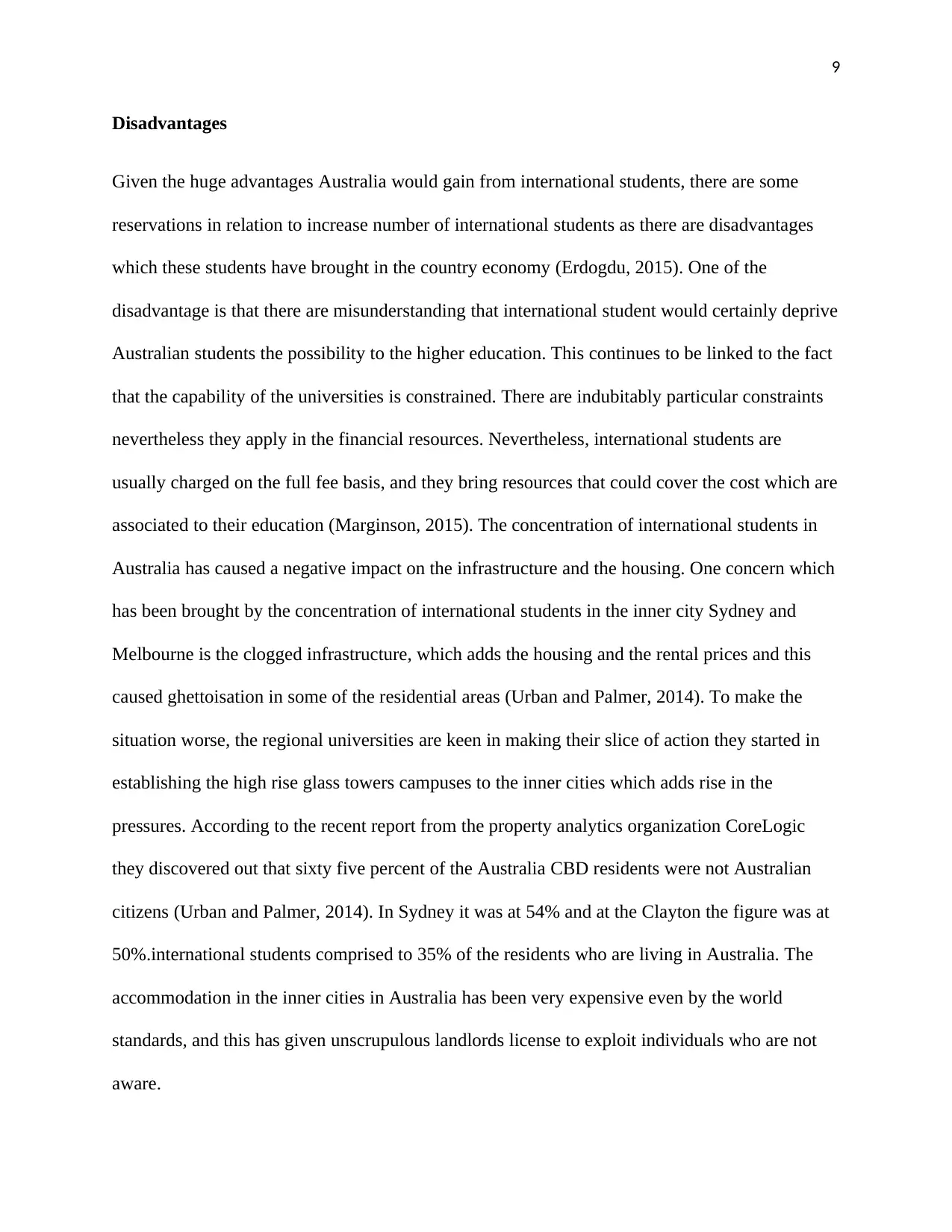
9
Disadvantages
Given the huge advantages Australia would gain from international students, there are some
reservations in relation to increase number of international students as there are disadvantages
which these students have brought in the country economy (Erdogdu, 2015). One of the
disadvantage is that there are misunderstanding that international student would certainly deprive
Australian students the possibility to the higher education. This continues to be linked to the fact
that the capability of the universities is constrained. There are indubitably particular constraints
nevertheless they apply in the financial resources. Nevertheless, international students are
usually charged on the full fee basis, and they bring resources that could cover the cost which are
associated to their education (Marginson, 2015). The concentration of international students in
Australia has caused a negative impact on the infrastructure and the housing. One concern which
has been brought by the concentration of international students in the inner city Sydney and
Melbourne is the clogged infrastructure, which adds the housing and the rental prices and this
caused ghettoisation in some of the residential areas (Urban and Palmer, 2014). To make the
situation worse, the regional universities are keen in making their slice of action they started in
establishing the high rise glass towers campuses to the inner cities which adds rise in the
pressures. According to the recent report from the property analytics organization CoreLogic
they discovered out that sixty five percent of the Australia CBD residents were not Australian
citizens (Urban and Palmer, 2014). In Sydney it was at 54% and at the Clayton the figure was at
50%.international students comprised to 35% of the residents who are living in Australia. The
accommodation in the inner cities in Australia has been very expensive even by the world
standards, and this has given unscrupulous landlords license to exploit individuals who are not
aware.
Disadvantages
Given the huge advantages Australia would gain from international students, there are some
reservations in relation to increase number of international students as there are disadvantages
which these students have brought in the country economy (Erdogdu, 2015). One of the
disadvantage is that there are misunderstanding that international student would certainly deprive
Australian students the possibility to the higher education. This continues to be linked to the fact
that the capability of the universities is constrained. There are indubitably particular constraints
nevertheless they apply in the financial resources. Nevertheless, international students are
usually charged on the full fee basis, and they bring resources that could cover the cost which are
associated to their education (Marginson, 2015). The concentration of international students in
Australia has caused a negative impact on the infrastructure and the housing. One concern which
has been brought by the concentration of international students in the inner city Sydney and
Melbourne is the clogged infrastructure, which adds the housing and the rental prices and this
caused ghettoisation in some of the residential areas (Urban and Palmer, 2014). To make the
situation worse, the regional universities are keen in making their slice of action they started in
establishing the high rise glass towers campuses to the inner cities which adds rise in the
pressures. According to the recent report from the property analytics organization CoreLogic
they discovered out that sixty five percent of the Australia CBD residents were not Australian
citizens (Urban and Palmer, 2014). In Sydney it was at 54% and at the Clayton the figure was at
50%.international students comprised to 35% of the residents who are living in Australia. The
accommodation in the inner cities in Australia has been very expensive even by the world
standards, and this has given unscrupulous landlords license to exploit individuals who are not
aware.
⊘ This is a preview!⊘
Do you want full access?
Subscribe today to unlock all pages.

Trusted by 1+ million students worldwide
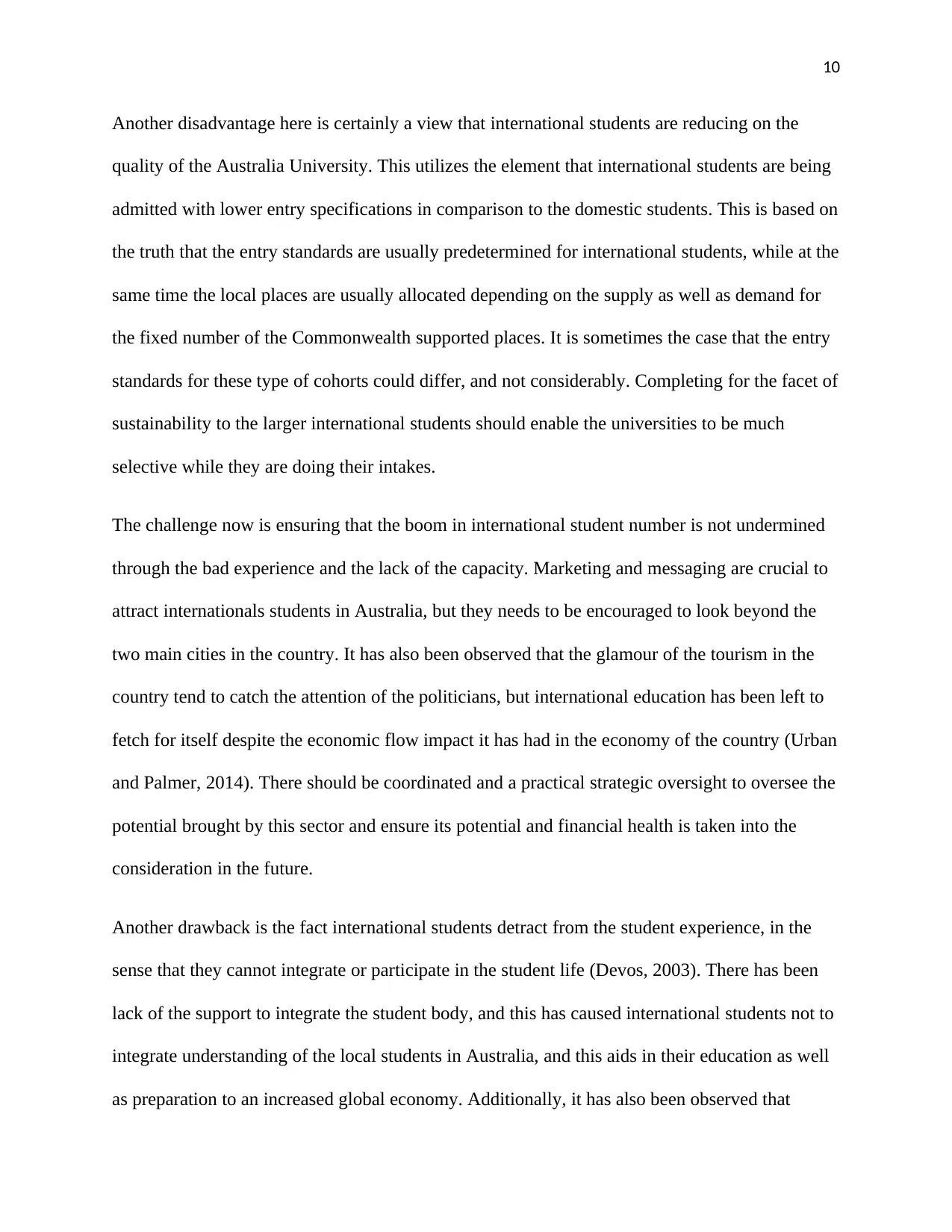
10
Another disadvantage here is certainly a view that international students are reducing on the
quality of the Australia University. This utilizes the element that international students are being
admitted with lower entry specifications in comparison to the domestic students. This is based on
the truth that the entry standards are usually predetermined for international students, while at the
same time the local places are usually allocated depending on the supply as well as demand for
the fixed number of the Commonwealth supported places. It is sometimes the case that the entry
standards for these type of cohorts could differ, and not considerably. Completing for the facet of
sustainability to the larger international students should enable the universities to be much
selective while they are doing their intakes.
The challenge now is ensuring that the boom in international student number is not undermined
through the bad experience and the lack of the capacity. Marketing and messaging are crucial to
attract internationals students in Australia, but they needs to be encouraged to look beyond the
two main cities in the country. It has also been observed that the glamour of the tourism in the
country tend to catch the attention of the politicians, but international education has been left to
fetch for itself despite the economic flow impact it has had in the economy of the country (Urban
and Palmer, 2014). There should be coordinated and a practical strategic oversight to oversee the
potential brought by this sector and ensure its potential and financial health is taken into the
consideration in the future.
Another drawback is the fact international students detract from the student experience, in the
sense that they cannot integrate or participate in the student life (Devos, 2003). There has been
lack of the support to integrate the student body, and this has caused international students not to
integrate understanding of the local students in Australia, and this aids in their education as well
as preparation to an increased global economy. Additionally, it has also been observed that
Another disadvantage here is certainly a view that international students are reducing on the
quality of the Australia University. This utilizes the element that international students are being
admitted with lower entry specifications in comparison to the domestic students. This is based on
the truth that the entry standards are usually predetermined for international students, while at the
same time the local places are usually allocated depending on the supply as well as demand for
the fixed number of the Commonwealth supported places. It is sometimes the case that the entry
standards for these type of cohorts could differ, and not considerably. Completing for the facet of
sustainability to the larger international students should enable the universities to be much
selective while they are doing their intakes.
The challenge now is ensuring that the boom in international student number is not undermined
through the bad experience and the lack of the capacity. Marketing and messaging are crucial to
attract internationals students in Australia, but they needs to be encouraged to look beyond the
two main cities in the country. It has also been observed that the glamour of the tourism in the
country tend to catch the attention of the politicians, but international education has been left to
fetch for itself despite the economic flow impact it has had in the economy of the country (Urban
and Palmer, 2014). There should be coordinated and a practical strategic oversight to oversee the
potential brought by this sector and ensure its potential and financial health is taken into the
consideration in the future.
Another drawback is the fact international students detract from the student experience, in the
sense that they cannot integrate or participate in the student life (Devos, 2003). There has been
lack of the support to integrate the student body, and this has caused international students not to
integrate understanding of the local students in Australia, and this aids in their education as well
as preparation to an increased global economy. Additionally, it has also been observed that
Paraphrase This Document
Need a fresh take? Get an instant paraphrase of this document with our AI Paraphraser
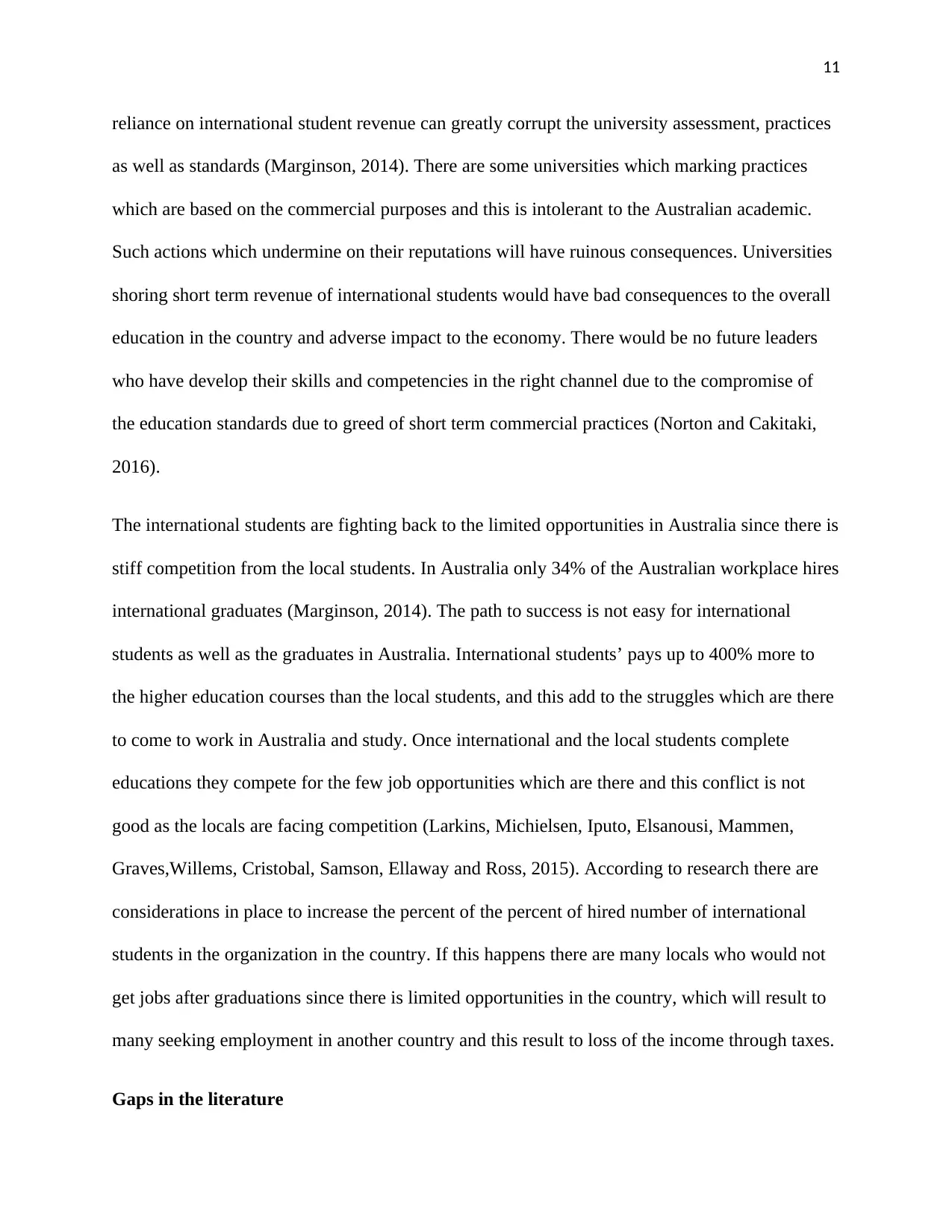
11
reliance on international student revenue can greatly corrupt the university assessment, practices
as well as standards (Marginson, 2014). There are some universities which marking practices
which are based on the commercial purposes and this is intolerant to the Australian academic.
Such actions which undermine on their reputations will have ruinous consequences. Universities
shoring short term revenue of international students would have bad consequences to the overall
education in the country and adverse impact to the economy. There would be no future leaders
who have develop their skills and competencies in the right channel due to the compromise of
the education standards due to greed of short term commercial practices (Norton and Cakitaki,
2016).
The international students are fighting back to the limited opportunities in Australia since there is
stiff competition from the local students. In Australia only 34% of the Australian workplace hires
international graduates (Marginson, 2014). The path to success is not easy for international
students as well as the graduates in Australia. International students’ pays up to 400% more to
the higher education courses than the local students, and this add to the struggles which are there
to come to work in Australia and study. Once international and the local students complete
educations they compete for the few job opportunities which are there and this conflict is not
good as the locals are facing competition (Larkins, Michielsen, Iputo, Elsanousi, Mammen,
Graves,Willems, Cristobal, Samson, Ellaway and Ross, 2015). According to research there are
considerations in place to increase the percent of the percent of hired number of international
students in the organization in the country. If this happens there are many locals who would not
get jobs after graduations since there is limited opportunities in the country, which will result to
many seeking employment in another country and this result to loss of the income through taxes.
Gaps in the literature
reliance on international student revenue can greatly corrupt the university assessment, practices
as well as standards (Marginson, 2014). There are some universities which marking practices
which are based on the commercial purposes and this is intolerant to the Australian academic.
Such actions which undermine on their reputations will have ruinous consequences. Universities
shoring short term revenue of international students would have bad consequences to the overall
education in the country and adverse impact to the economy. There would be no future leaders
who have develop their skills and competencies in the right channel due to the compromise of
the education standards due to greed of short term commercial practices (Norton and Cakitaki,
2016).
The international students are fighting back to the limited opportunities in Australia since there is
stiff competition from the local students. In Australia only 34% of the Australian workplace hires
international graduates (Marginson, 2014). The path to success is not easy for international
students as well as the graduates in Australia. International students’ pays up to 400% more to
the higher education courses than the local students, and this add to the struggles which are there
to come to work in Australia and study. Once international and the local students complete
educations they compete for the few job opportunities which are there and this conflict is not
good as the locals are facing competition (Larkins, Michielsen, Iputo, Elsanousi, Mammen,
Graves,Willems, Cristobal, Samson, Ellaway and Ross, 2015). According to research there are
considerations in place to increase the percent of the percent of hired number of international
students in the organization in the country. If this happens there are many locals who would not
get jobs after graduations since there is limited opportunities in the country, which will result to
many seeking employment in another country and this result to loss of the income through taxes.
Gaps in the literature
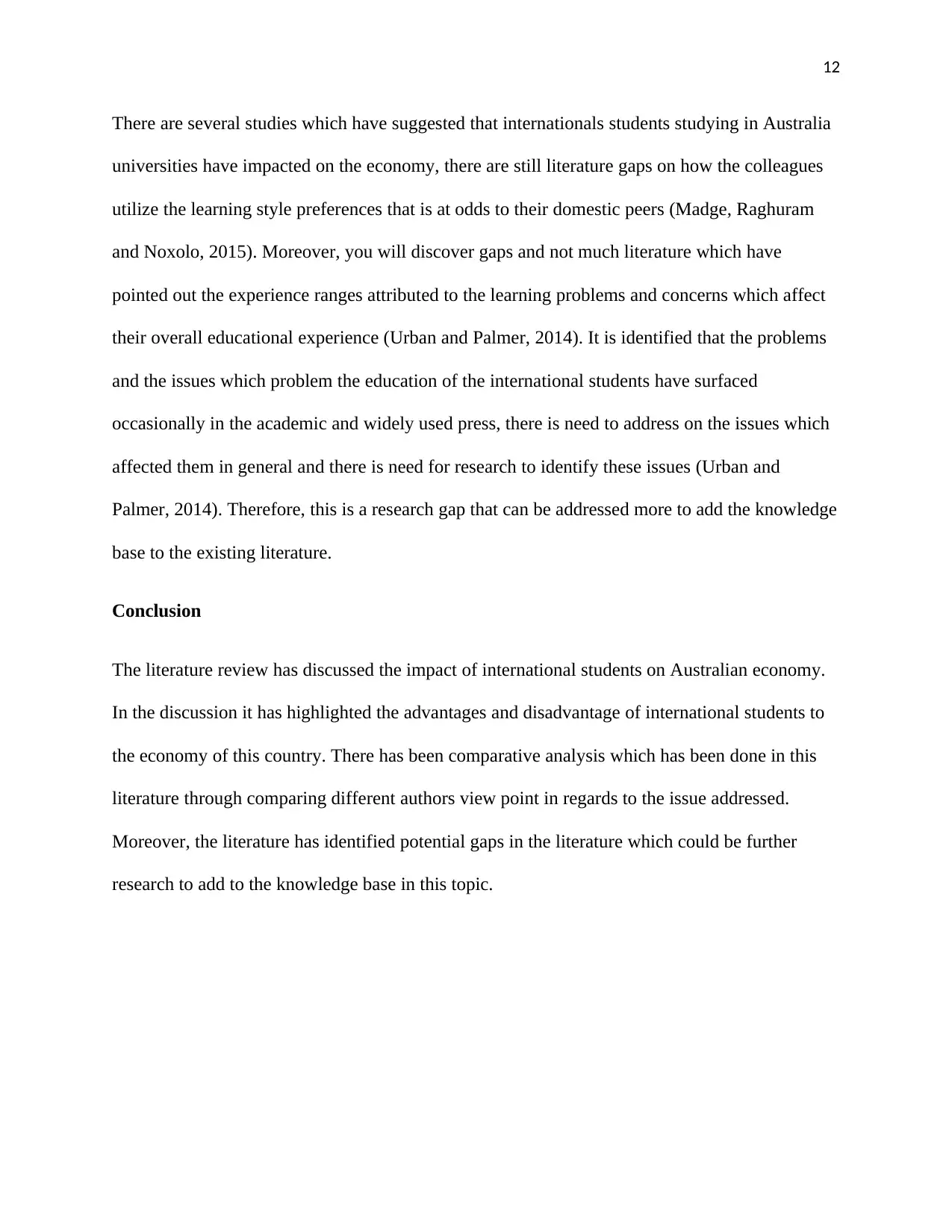
12
There are several studies which have suggested that internationals students studying in Australia
universities have impacted on the economy, there are still literature gaps on how the colleagues
utilize the learning style preferences that is at odds to their domestic peers (Madge, Raghuram
and Noxolo, 2015). Moreover, you will discover gaps and not much literature which have
pointed out the experience ranges attributed to the learning problems and concerns which affect
their overall educational experience (Urban and Palmer, 2014). It is identified that the problems
and the issues which problem the education of the international students have surfaced
occasionally in the academic and widely used press, there is need to address on the issues which
affected them in general and there is need for research to identify these issues (Urban and
Palmer, 2014). Therefore, this is a research gap that can be addressed more to add the knowledge
base to the existing literature.
Conclusion
The literature review has discussed the impact of international students on Australian economy.
In the discussion it has highlighted the advantages and disadvantage of international students to
the economy of this country. There has been comparative analysis which has been done in this
literature through comparing different authors view point in regards to the issue addressed.
Moreover, the literature has identified potential gaps in the literature which could be further
research to add to the knowledge base in this topic.
There are several studies which have suggested that internationals students studying in Australia
universities have impacted on the economy, there are still literature gaps on how the colleagues
utilize the learning style preferences that is at odds to their domestic peers (Madge, Raghuram
and Noxolo, 2015). Moreover, you will discover gaps and not much literature which have
pointed out the experience ranges attributed to the learning problems and concerns which affect
their overall educational experience (Urban and Palmer, 2014). It is identified that the problems
and the issues which problem the education of the international students have surfaced
occasionally in the academic and widely used press, there is need to address on the issues which
affected them in general and there is need for research to identify these issues (Urban and
Palmer, 2014). Therefore, this is a research gap that can be addressed more to add the knowledge
base to the existing literature.
Conclusion
The literature review has discussed the impact of international students on Australian economy.
In the discussion it has highlighted the advantages and disadvantage of international students to
the economy of this country. There has been comparative analysis which has been done in this
literature through comparing different authors view point in regards to the issue addressed.
Moreover, the literature has identified potential gaps in the literature which could be further
research to add to the knowledge base in this topic.
⊘ This is a preview!⊘
Do you want full access?
Subscribe today to unlock all pages.

Trusted by 1+ million students worldwide
1 out of 14
Related Documents
Your All-in-One AI-Powered Toolkit for Academic Success.
+13062052269
info@desklib.com
Available 24*7 on WhatsApp / Email
![[object Object]](/_next/static/media/star-bottom.7253800d.svg)
Unlock your academic potential
Copyright © 2020–2025 A2Z Services. All Rights Reserved. Developed and managed by ZUCOL.





